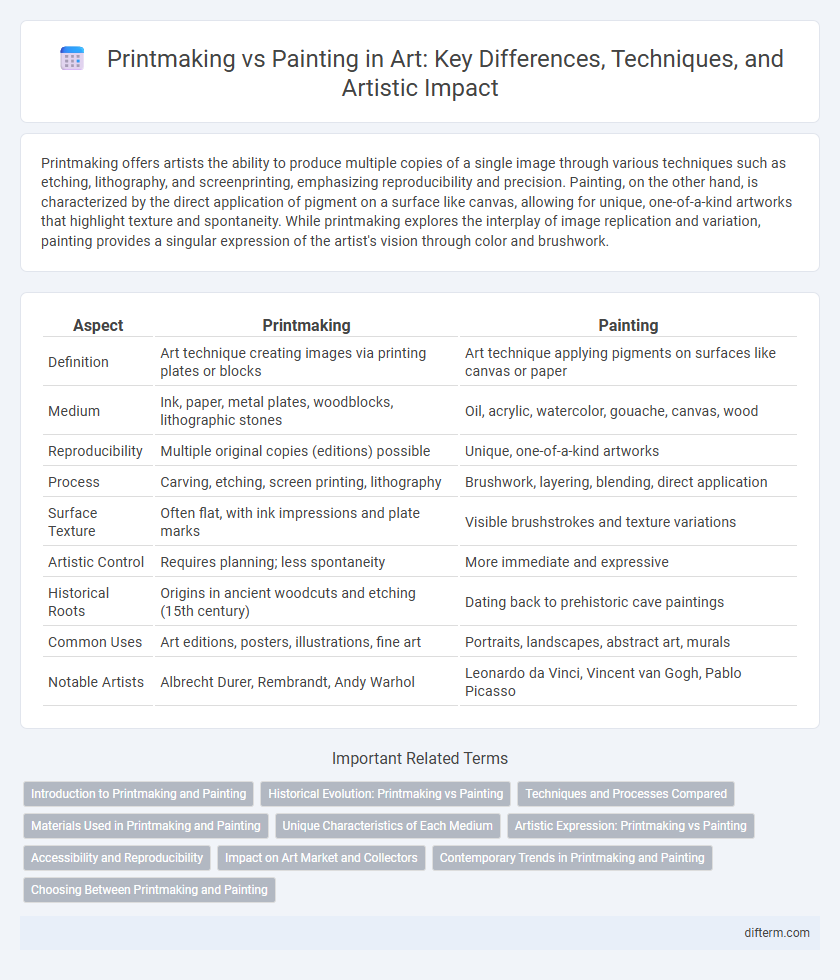Printmaking offers artists the ability to produce multiple copies of a single image through various techniques such as etching, lithography, and screenprinting, emphasizing reproducibility and precision. Painting, on the other hand, is characterized by the direct application of pigment on a surface like canvas, allowing for unique, one-of-a-kind artworks that highlight texture and spontaneity. While printmaking explores the interplay of image replication and variation, painting provides a singular expression of the artist's vision through color and brushwork.
Table of Comparison
| Aspect | Printmaking | Painting |
|---|---|---|
| Definition | Art technique creating images via printing plates or blocks | Art technique applying pigments on surfaces like canvas or paper |
| Medium | Ink, paper, metal plates, woodblocks, lithographic stones | Oil, acrylic, watercolor, gouache, canvas, wood |
| Reproducibility | Multiple original copies (editions) possible | Unique, one-of-a-kind artworks |
| Process | Carving, etching, screen printing, lithography | Brushwork, layering, blending, direct application |
| Surface Texture | Often flat, with ink impressions and plate marks | Visible brushstrokes and texture variations |
| Artistic Control | Requires planning; less spontaneity | More immediate and expressive |
| Historical Roots | Origins in ancient woodcuts and etching (15th century) | Dating back to prehistoric cave paintings |
| Common Uses | Art editions, posters, illustrations, fine art | Portraits, landscapes, abstract art, murals |
| Notable Artists | Albrecht Durer, Rembrandt, Andy Warhol | Leonardo da Vinci, Vincent van Gogh, Pablo Picasso |
Introduction to Printmaking and Painting
Printmaking involves creating multiple copies of an image through techniques like etching, lithography, and screen printing, allowing artists to experiment with texture and layering in ways distinct from painting. Painting uses mediums such as oil, acrylic, or watercolor applied directly on surfaces like canvas or wood, emphasizing color blending and brushwork. Both disciplines offer unique expressive possibilities, with printmaking focusing on reproducibility and graphic precision, while painting highlights individual brushstroke and color depth.
Historical Evolution: Printmaking vs Painting
Printmaking emerged in the 15th century as a revolutionary technique allowing multiple reproductions of artworks, contrasting with the unique, singular nature of painting that dates back to prehistoric times. The development of printmaking methods, such as woodcut, etching, and lithography, played a crucial role in democratizing art by making images more accessible to the masses. Painting evolved through various art movements--Renaissance, Baroque, Impressionism--each emphasizing originality and expressive brushwork, while printmaking maintained its function in mass communication and artistic replication.
Techniques and Processes Compared
Printmaking involves creating images through transferring ink from a matrix, such as a woodblock or metal plate, to paper, emphasizing techniques like etching, lithography, and screenprinting that allow for multiple reproductions. Painting relies on direct application of pigments onto surfaces like canvas, employing methods such as brushwork, layering, and glazing to achieve texture and color depth unique to each piece. The fundamental difference lies in printmaking's capacity for replication and precision versus painting's singular and tactile expression.
Materials Used in Printmaking and Painting
Printmaking primarily utilizes materials such as plates made of metal, wood, or linoleum, along with inks and specialized papers that absorb pigment differently compared to canvas. In contrast, painting relies on pigments suspended in binders like oil, acrylic, or watercolor, applied directly onto surfaces including canvas, wood, or paper. The choice of materials in printmaking influences texture and reproducibility, whereas painting materials emphasize color blending and brushwork effects.
Unique Characteristics of Each Medium
Printmaking offers reproducibility through techniques like etching, lithography, and screen printing, allowing artists to create multiple editions with consistent detail. Painting emphasizes texture, color blending, and brushstroke individuality, providing a one-of-a-kind original artwork deeply connected to the artist's hand. Both mediums enable distinct expressions: printmaking excels in precision and replication, while painting highlights spontaneity and tactile variation.
Artistic Expression: Printmaking vs Painting
Printmaking allows artists to explore repetition and texture through techniques such as etching, lithography, and screen printing, enabling multiple copies of a single work while maintaining unique variations in each print. Painting offers greater immediacy and spontaneity in artistic expression, with direct manipulation of color, brushstrokes, and surface that can convey emotion and depth more fluidly. Both mediums provide distinct avenues for creativity, with printmaking emphasizing precision and reproducibility, and painting emphasizing individuality and dynamic gesture.
Accessibility and Reproducibility
Printmaking offers greater accessibility and reproducibility compared to painting, allowing artists to produce multiple identical copies of their work efficiently. This technique lowers barriers for art collectors by providing affordable editions without sacrificing quality. In contrast, paintings remain unique, often limiting access due to higher costs and exclusivity.
Impact on Art Market and Collectors
Printmaking offers greater accessibility and affordability than painting, attracting a broader base of collectors and impacting the art market by increasing art circulation. Limited edition prints create scarcity while maintaining affordability, driving demand and allowing emerging artists to gain visibility. Paintings typically command higher prices and prestige, making them primary assets for high-end collectors and investors in the art market.
Contemporary Trends in Printmaking and Painting
Contemporary printmaking leverages digital technology and mixed media to push traditional boundaries, creating complex, layered artworks that blend tactile and virtual elements. Painting trends emphasize experimental techniques, including textured surfaces and unconventional materials, fostering dynamic, immersive visual experiences. Both mediums increasingly intersect, reflecting a broader shift towards hybridity and innovation in contemporary art practices.
Choosing Between Printmaking and Painting
Choosing between printmaking and painting involves considering the unique techniques and outcomes of each medium. Printmaking allows artists to produce multiple original copies with intricate textures and patterns, while painting offers a singular, expressive canvas emphasizing brushwork and color blending. Artists should evaluate their desired reproducibility, texture, and creative process to determine the best fit for their artistic goals.
printmaking vs painting Infographic

 difterm.com
difterm.com